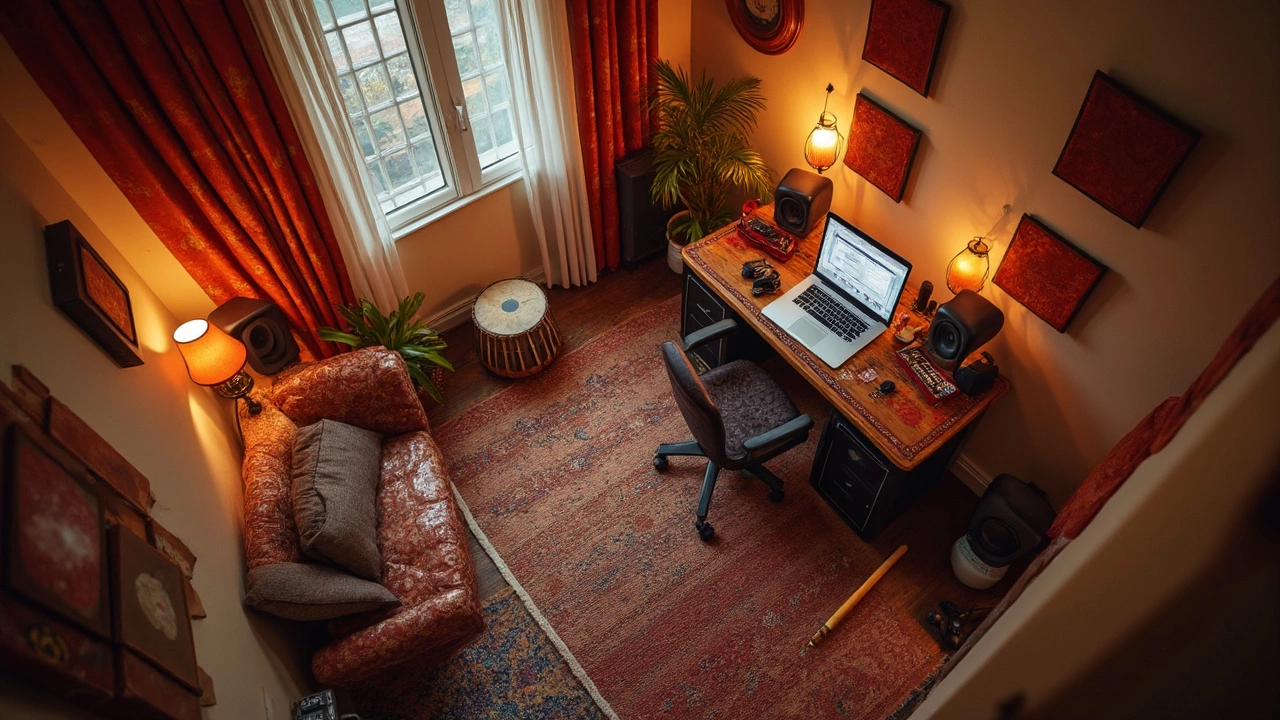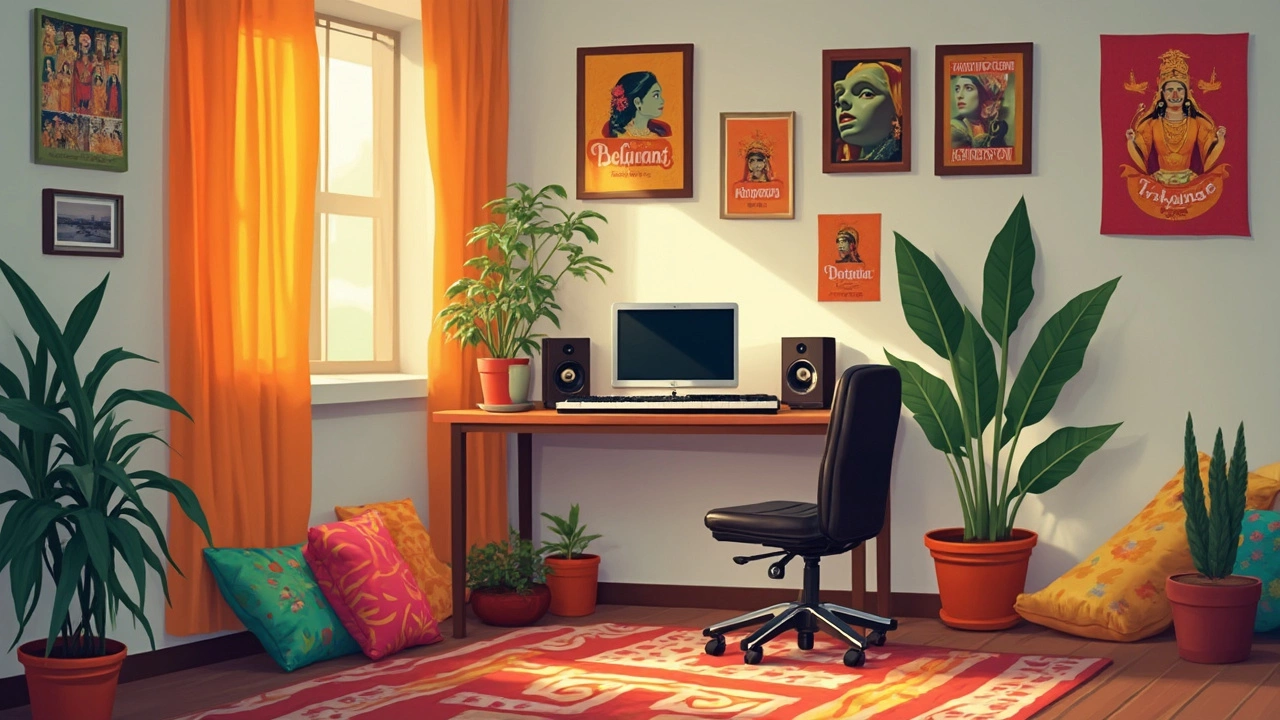Think you need a big, fancy room to start a home studio? You really don’t. With the right approach, even the smallest nook in a city flat can do the trick. Some producers in Mumbai or Bangalore are working out of closets, not massive soundproof rooms. Tight budgets and limited space push you to get creative.
The real game-changer is understanding what actually matters for a studio. It’s not the square footage—it’s what you put in the room, and how you use it. If you can fit a chair, a small desk, and your essential gear, you’re off to a good start. Many hit tracks have been made in spaces no bigger than your bathroom. Size isn’t a dealbreaker; smart setup is.
- Rethinking Space: What Do You Really Need?
- Minimum Space Requirements—Fact or Myth?
- Smart Gear Choices for Tiny Studios
- Making the Most of Every Inch
Rethinking Space: What Do You Really Need?
If you’ve ever scrolled through YouTube and seen those pro studio tours—yeah, don’t get fooled. Most of that gear and massive space is overkill for home recording. When space is tight, it’s time to focus on what you actually need—no more, no less.
Let’s break down the basics. You can start a perfectly decent home studio size with just a few key things. Here’s what should be on your must-have list:
- Computer or laptop (pretty much the brains of everything)
- Audio interface (brings pro sound into a small setup)
- Headphones or a pair of small, decent studio monitors
- Microphone (even one good one can do the job)
- Desk and chair (not huge, just comfortable and sturdy)
- Basic acoustic treatment—think foam panels, blankets, or even mattresses propped against a wall
If you’re mostly working with digital instruments or beats, you might not even need monitors at first. Headphones take up no space and can be surprisingly accurate, especially in apartments where you can’t crank up the volume anyway.
Here’s a quick look at what most first-time home studio folks in India really use to get going:
| Item | Typical Size/Requirement | Notes |
|---|---|---|
| Laptop | 38x26 cm desk area | Any decent dual-core machine works |
| Audio Interface | 15x13 cm desk area | USB-powered is easiest for small spaces |
| Headphones | Hooks on wall or desk | Zero desk space needed when not in use |
| Microphone | Table stand/mic arm | Clamp to desk or use a small corner stand |
| Treatment | Foldable/portable | Foam panels, thick blankets, old mattresses |
The truth? You don’t need a dedicated room. A corner in your bedroom, a balcony space, or heck—some folks work from under the staircase. It’s about working with whatever space you have, not waiting to stumble on some dream studio. Less clutter, fewer distractions, and just the right gear: that’s all you need to kick things off.
Minimum Space Requirements—Fact or Myth?
People often think you need at least a dedicated room to build a home studio, but the truth is, you don’t. There’s no universal rule that says your studio must be a certain size, especially if you’re just starting out with a home studio size that fits your living situation. What matters way more is how you lay out your gear and manage your sound.
Let’s get real: many famous producers started out with just a corner or a closet. Some studios barely squeeze into 6x6 feet, or even less—about the size of a big cupboard. More than size, focus on making your space functional. You need enough room for three things: your desk or table, your main gear (like a laptop or audio interface), and a comfortable chair. If you can shut yourself in and not get interrupted, you’re already ahead.
In small Indian flats, it’s totally normal to be tight on space. Here’s what you truly need to watch for:
- Ventilation: Don’t trade off fresh air for quiet—tiny, closed spaces get stuffy fast.
- Noise: Make sure you can block out loud street sounds or loud family members. Thick curtains or foam panels help a lot, even in really tiny spaces.
- Power: Check that you’ve got a couple of plug points nearby. Extension cords will save you a ton of hassle.
- Distractions: The smaller your setup, the more easily sound bounces—keep random stuff (boxes, bags) to a minimum.
Is there a "best" minimum size? Not really. Even a 4x4 foot alcove can work if you’re careful with your setup and stick to essential equipment. The trick is to be practical, not traditional: make your space fit your workflow instead of forcing studio ‘rules’ onto your home.

Smart Gear Choices for Tiny Studios
When space is tight, your gear choices can make or break your whole home studio setup. The trick is to pick compact tools that punch above their weight. You want to save both cash and space, without skimping on sound. Let's get straight to the real must-haves.
The essentials are simple: a laptop or desktop with good specs, an audio interface, one or two solid studio monitors, a pair of closed-back headphones, and a microphone. Don’t go wild with extra gear. Instead, invest in multi-purpose items.
- Home studio size matters less if your audio interface is portable, like the Focusrite Scarlett Solo or the PreSonus AudioBox USB 96. These fit in your hand but do the job for most home recording.
- A compact 25 or 32-key MIDI controller fits easily on a tiny desk. Bigger keyboards crowd everything—so brands like Akai and Arturia get popular for this reason.
- Monitors don’t have to be massive. KRK Rokit 5 or Yamaha HS5 are studio favorites because they’re accurate but not bulky. If monitors feel too big, you can even start with just headphones like the Audio-Technica ATH-M50x.
- Forget about giant condenser mics that need loads of space—look at something like the Audio-Technica AT2020 or the Shure SM57. These are small, reliable, and known for handling Indian room noise better than you’d expect.
- Laptop stands, wall shelves, and desktop mic mounts free up plenty of room on the table for mixing or note-taking.
If you’re worried about your small studio overheating or feeling crowded, keep cables tidy with velcro ties, and stash extra stuff in stackable bins or drawers. Try to keep the workspace as open as possible so you don’t feel boxed in.
| Item | Space Needed | Popular Models (India) |
|---|---|---|
| Audio Interface | 20x13 cm | Focusrite Scarlett Solo, PreSonus AudioBox USB 96 |
| MIDI Keyboard | 35x15 cm | Akai MPK Mini, Arturia MiniLab |
| Monitors (pair) | 36x25 cm | KRK Rokit 5, Yamaha HS5 |
| Headphones | 15x18 cm (stored) | Audio-Technica ATH-M50x |
| Microphone | 8x18 cm (with stand) | Audio-Technica AT2020, Shure SM57 |
Staying lean with your gear means faster setup, less cleaning, and no wasted money. If you plan smart, your tiny studio can sound just as good as any fancy setup—minus the clutter and headaches.
Making the Most of Every Inch
So, your home studio is small—really small. Maybe it’s the end of your bed, a cramped balcony, or a corner behind your cupboard. Don’t sweat it. With a bit of planning, you’ll get professional results without knocking down walls.
First, get your layout sorted. Desk placement is important. Try to keep your speakers (monitors) pointed down the length of the room—even if that means rearranging furniture. For most Indian rooms, that means placing your desk a foot or two from the shortest wall. It sounds weird, but you’ll hear more detail and fewer weird echoes that way.
Next, go vertical. Shelves above your desk save loads of space for cables, audio interfaces, and your coffee mug. Use wall hooks for headphones and cables. There’s no rule that every piece of kit needs desk real estate.
Deal with the real sound killers: reflections and unwanted noise. Even in a tight spot, hanging thick curtains or simple foam panels on nearby walls makes a big difference. If you rent, you don’t have to destroy your security deposit—adhesive strips and command hooks do the job. A pro tip: thick mattresses or duvets can also absorb sound if you’re really squeezed.
Here’s what space-saving efficiency can look like in numbers:
| Studio Element | Space Required (Approx.) | Placement Tip |
|---|---|---|
| Desk & Chair | 1.2m x 0.6m | Push against shortest wall |
| Studio Monitors | 15-20cm each side | Ear height, on desk stands or wall mounts |
| Acoustic Panels | 0.6m x 0.6m/panel | Place at ear level, first reflection points |
| Audio Interface | Hand-sized | Mount underside of desk or on side shelf |
Don’t forget about cable management. Messy cables take up space and trip you up. Velcro ties are cheap and a quick fix.
- Mount gear under your desk—USB hubs, small interfaces, power strips. It keeps the work surface clean.
- Stack gear with shelves, not just desk space. Modular racks exist, but even a metal shoe rack works.
- Get creative with multi-use furniture. A sturdy keyboard stand doubles as storage underneath. Some folks in major cities even use fold-down desks that tuck away after the session.
With all this, you’ll squeeze out serious productivity no matter how compact your home studio size is. Make the space work for you, not the other way around.





